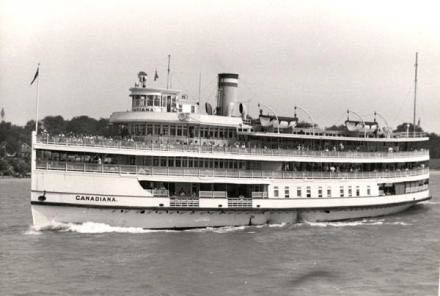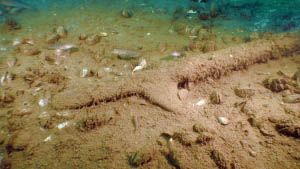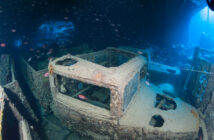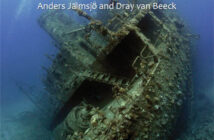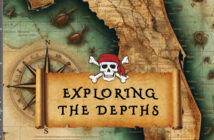It is the early summer of 1943 and the British Commonwealth Air Training Plan is well into its fourth year of existence. Potential air crews from across the Commonwealth are gathered and training is in high gear producing well-trained crews capable of contributing to the war effort. Across Canada the skies are filled with the droning sounds of training aircraft of many types. Those aboard the aircraft are hoping to become the next pilots, gunners, navigators, wireless operators or bombardiers that are needed to ensure that victory will come to the Allied powers. Unfortunately not all of the potential air crew will live long enough to complete their training and join their comrades in a theatre of war. This is an account of one young man whose tragic actions prevented him from making it back to England to defend his country.
The S.S. Canadiana was a 215 foot long steamship built in the Buffalo Dry Dock and holds the dubious distinction of being the last passenger vessel to be built in Buffalo. She became affectionately known as the “Crystal Beach Boat” due to her frequent travel between Buffalo, New York and the Crystal Beach Amusement Park in Ontario. Built in 1910, the ship was a popular choice for travel between Buffalo and Canadian ports. With gasoline rationing in place during the war the ferry was regarded as the cheapest method of travel. During her voyages one could often enjoy a big band concert performed by some of the popular entertainers of the day. Cab Calloway, Duke Ellington and Guy Lombardo are all known to have performed for her passengers. While the ship would occasionally journey to other destinations such as Port Colborne, her main passage was the round-trip sailing from Buffalo to Crystal Beach.
On the 19th of June, 1943 the Canadiana was once again enroute to Crystal Beach. Among her approximately 1000 passengers were Flying Officer Ross Finlayson and Pilot Officer Joseph Swisko. Both were from #6 Service Flying Training School, RCAF Station Dunnville. F/O Finlayson was serving as a flying instructor and P/O Swisko was a staff pilot. Each of the men were returning from a 48 hour pass. What they would witness on the voyage back to their BCATP station and their testimony would later become vital evidence in determining the recommendations of a Court of Inquiry.
Leading Aircraftman William Charles Smith was a 17-year old RAF Volunteer Reserve pilot-in-training at #6 SFTS. Since commencing his flying training he had accumulated 142 hours of flying time which was comprised of 67.45 flying hours in the Tiger Moth and 74.15 hours in the Harvard. He was well on his way to earning his wings. After all, his instructors had considered him to be a ‘higher than average’ pilot. After being granted authorization that day by F/O Ballachey to commence several practice sequences (his regular instructor, F/O Elliot being away on a 48 hour pass), LAC Smith climbed into Harvard 2963 and took off from RCAF Station Dunnville at 1425 hours. Not long after taking off from #6 SFTS LAC Smith apparently became bored with his maneuvers and decided to look for a more entertaining form of practice.
At approximately 1450 hours the Leading Aircraftman had wandered 13 miles away from the authorized training area and over to Lake Erie. It was there, that he found the Canadiana innocently steaming to her destination. With his ‘sights’ set on his new-found distraction he started to make circuits around the ship at the lofty altitude of approximately 20 feet from the water’s surface. P/O Swisko later testified at the Court of Inquiry that he had witnessed ‘several circuits of the boat’ with each subsequent pass coming nearer to the water. Meanwhile, LAC Smith’s aircraft had drawn a crowd to the deck to witness the exhibition. Many of them were children who were in awe of the spectacle and were seen waving to the pilot. With each pass the young pilot drew nearer to the water. At some point he spotted a new target and left the Canadiana to harass the crew of a nearby tanker. F/O Finlayson, had been watching the display from the deck of the ship, and noted the time as 1500 hours. He recognized the aircraft as one from his very own #6 SFTS and had planned on reporting the unauthorized flying upon his return to the station.
LAC Smith must have again become bored because, after spending some time ‘attacking’ the tanker he once again set his sights on the Canadiana. Coming in even lower the next few times, he would zoom in on the ferry before climbing to cross over the ship. Witnesses reported that the aircraft would ‘mush’ forward a little each time before making the steep climbing turn to make another pass. P/O Swisko, realized the peril that the zooming Harvard imposed upon the ship, and went to the rail to wave the young pilot off. He reported his actions:
“I who had my blue uniform on stood up close to the rail so that he could see me and waved to him indicating that he should move off. When he came back he was flying with his left hand and waved to me with his right. I could see his eyes focused on me and grinning”.
His efforts were to no avail as the aircraft once again descended and turned into the Canadiana.
First Mate Thomas Fagen was on duty in the pilot house aboard the Canadiana that day. From his station on the bridge he reported seeing the aircraft make several runs at the ship with each run being closer to the water than the last. Each time the aircraft would pull up, ‘just missing’ the pilot house. On the airplane’s final pass, First Mate Fagen saw the aircraft “hit the water about 50 feet from the boat” and heard the impact. He immediately stopped the steamer and a boat was lowered. By the time the boat arrived at the site of the accident, all that was left was an oil slick.
F/O Finlayson happened to be standing on the port stern of the boat when Harvard 2963 made its’ final pass. As the young pilot zoomed over the ship from the stern he made a steep climbing turn to pass over the steamer. Finlayson lost sight of the aircraft as it passed over but could hear P/O Swisko yell “There he goes”. F/O Finlayson ran to the starboard side just in time to see the aircraft strike the water. According to Finlayson,
“I heard a report like a good, sharp, bang, saw bluish grey smoke issue with parts of the aircraft mingled in it. The side panels came away, the port fin and elevators and fin and rudder flew off- starboard wing flew off at the point where it joins the centre section, and the fuselage bobbed in the water for a few seconds. The starboard wing floated for maybe a half minute before it went down.”
P/O Swisko’s testimony was remarkably similar, with the exception that, while he did not observe any fire he believed that the left fuel tank had exploded upon impact.
P/O Swisko observed that just prior to the impact the aircraft appeared to be travelling at about 100 mph, was ‘wave-hopping’ at just 5 to 8 feet above the water, and was coming along the port side making a steep slipping turn to the right. From his vantage point he saw the aircraft reach about 75 feet of altitude before seeing the tell-tale signs of a stall, with the right wing ‘flicking’ three times. At 1507 hours the Harvard nosed down and struck the water almost head-on, with the port wing impacting slightly ahead of the main fuselage.
The Canadiana immediately radioed news of the accident. A nearby tanker, possibly the same one that Smith had ‘attacked’ earlier, arrived on scene. With nothing to do except wait until further help arrived, both ships stayed on station at the scene until US Coast Guard ships arrived. A US Civil Air Patrol plane was also dispatched and remained on station for 45 minutes but no signs of wreckage could be seen through the clear water below. At 2000hrs the USCGS Crocus arrived on scene and began recovery operations. After four unsuccessful recovery attempts the aircraft along with its pilot was finally raised at 0100 hours the next morning. Using a chain around the main part of the fuselage the aircraft was lifted and placed aboard the Crocus.
Although the force of the impact caused him to break through his Sutton harness, the body of LAC Smith had remained within the aircraft. Medical reports from a post-crash examination state that Smith had received severe head injuries and lacerations where he had struck the instrument panel. There were several fractures to his legs and third degree burns to his arms and torso. The impact had broken the Harvard’s control column in two. The recovered aircraft was very badly broken up, with the engine, side panels, and wings remaining at the bottom of the lake.
In 2006, divers from the Fort Erie Underwater Recovery Unit & Scuba Club discovered wreckage of what was obviously a vintage aircraft in Lake Erie. They contacted the CHAA Aircraft Recovery Team in an effort to identify their find. With some research and a few trips to the National Archives, the CHAA team was able to identify this aircraft by its location after resting on the bottom of Lake Erie for some sixty-odd years, as Harvard 2963. Members of the Aircraft Recovery Team have since then made a number of dives on the site in order to survey the wreckage and to better document the find.
Portions of the aircraft still remain littered across the lake floor. The engine and portions of the side panels are still recognizable above the lake bottom. The main gear struts are visible with one of the tires lying close by, still partially inflated. Remnants of the wing centre section exist. The site is scattered with pieces of exhaust tubes, crumpled aluminum, and engine parts embedded in the lake floor. The state of these remaining parts laying together, yet apart, is a testament to the violence of the impact of LAC Smith’s Harvard.
Unfortunately nature has begun to take its toll. Zebra mussels now blanket much of the remains, turning some of the smaller artifacts into barely recognizable heaps. Silting has also occurred. At times the shifting sands of the lake bottom reveal and then quickly hide the evidence of this disaster. Many of the once easily identifiable remnants are quickly becoming ‘healed over’ as the lake claims the wreckage for itself.
Since the wreckage was first discovered efforts have been made to preserve and document this site. While it is not a noteworthy site for a recovery or from a restoration point of view, the fact that it is now known means that it can be documented and acknowledged as a site of historical value and is, of itself, a reason to conduct further work and investigation.
Working in partnership with the No 6 RCAF Dunnville Museum, the Government of Ontario, and the Canadian Conservation Institute, the CHAA Aircraft Recovery Team is currently formulating a plan to raise a portion of the wreckage. Once recovered and properly conserved it is planned that the piece will be used as part of the Dunnville museum’s permanent display to honour those that flew as part of the British Commonwealth Air Training Plan and as a fitting memorial to Leading Aircraftman William Smith.
The remains of LAC Smith lay interred at the Riverside Cemetery, Lot 845, Grave 2 in Dunnville, Ontario.
Throughout the war years many aircrew and airplanes met their fate in the Great Lakes. Some aircraft and their crew survive as known wreckage, scattered along the bottom of Lakes Huron, Erie, Ontario, Michigan and Superior.
Some are yet to be found.
Often they are only exposed at the whim of the lakes, their stories still waiting to be told.
Every so often one raises its hand and proclaims;
‘Here I am’




